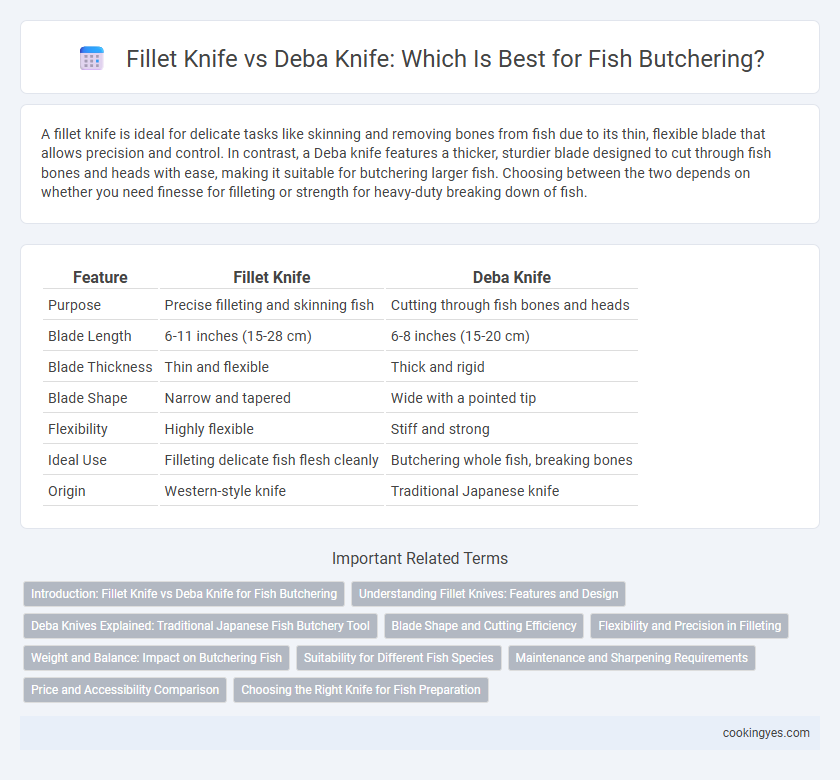A fillet knife is ideal for delicate tasks like skinning and removing bones from fish due to its thin, flexible blade that allows precision and control. In contrast, a Deba knife features a thicker, sturdier blade designed to cut through fish bones and heads with ease, making it suitable for butchering larger fish. Choosing between the two depends on whether you need finesse for filleting or strength for heavy-duty breaking down of fish.
Table of Comparison
| Feature | Fillet Knife | Deba Knife |
|---|---|---|
| Purpose | Precise filleting and skinning fish | Cutting through fish bones and heads |
| Blade Length | 6-11 inches (15-28 cm) | 6-8 inches (15-20 cm) |
| Blade Thickness | Thin and flexible | Thick and rigid |
| Blade Shape | Narrow and tapered | Wide with a pointed tip |
| Flexibility | Highly flexible | Stiff and strong |
| Ideal Use | Filleting delicate fish flesh cleanly | Butchering whole fish, breaking bones |
| Origin | Western-style knife | Traditional Japanese knife |
Introduction: Fillet Knife vs Deba Knife for Fish Butchering
Fillet knives feature long, thin, and flexible blades designed to make precise cuts along fish bones, ideal for skinning and filleting delicate fish with maximum yield. In contrast, Deba knives possess a thicker, heavier blade crafted from carbon steel, optimized for breaking down whole fish by cutting through bones and tough parts with controlled power. Choosing between a fillet knife and a Deba knife depends on the specific fish butchering task, whether it requires delicate filleting or heavy-duty fish breakup.
Understanding Fillet Knives: Features and Design
Fillet knives feature long, thin, and flexible blades specifically designed to separate delicate fish flesh from the bone with precision. Their sharp, tapered edges allow for smooth, clean cuts essential for filleting tasks, minimizing waste and preserving the fish's texture. The ergonomic handles provide superior control and comfort during intricate slicing, making them indispensable tools in fish processing.
Deba Knives Explained: Traditional Japanese Fish Butchery Tool
Deba knives are traditional Japanese tools designed for precise fish butchering, featuring a thick, sturdy blade ideal for cutting through fish bones and heads. Unlike fillet knives, which have flexible, thin blades suited for delicate flesh removal, Deba knives provide durability and sharpness required for heavy-duty tasks. Their single-bevel edge ensures clean cuts and maintains sharpness longer, making them essential for authentic Japanese culinary techniques.
Blade Shape and Cutting Efficiency
Fillet knives feature long, narrow, and flexible blades designed for precise slicing and separating delicate fish flesh from bones, enhancing cutting efficiency for filleting tasks. Deba knives possess thick, sturdy, and slightly curved blades optimized for cutting through fish bones and tougher parts, providing superior power and durability in butchering whole fish. The contrasting blade shapes directly influence cutting performance, with fillet knives excelling in finesse and deba knives offering strength for heavy-duty fish processing.
Flexibility and Precision in Filleting
Fillet knives offer superior flexibility, allowing for delicate, precise cuts along fish bones and skin, ideal for removing fillets with minimal waste. In contrast, Deba knives are rigid and heavier, designed for butchering tasks like breaking down fish heads and bones rather than detailed filleting. Choosing a fillet knife enhances precision in separating flesh from bone, making it the preferred tool for fine fish preparation.
Weight and Balance: Impact on Butchering Fish
Fillet knives are lightweight and flexible, allowing precise control and delicate slicing ideal for removing thin fillets and skinning fish. Deba knives are heavier and sturdier, providing excellent balance for cutting through fish bones and heads with more power and stability. The weight and balance differences influence cutting techniques, where fillet knives favor finesse while Deba knives excel in butchering tasks requiring strength.
Suitability for Different Fish Species
Fillet knives feature thin, flexible blades ideal for delicate fish like trout and salmon, enabling precise cuts that preserve flesh integrity. Deba knives, with their thick, sturdy construction, excel at handling tougher fish such as tuna and mackerel, efficiently breaking down bones and head sections. Selecting between these knives depends on fish species, weight, and the specific butchering task to ensure optimal processing and minimal waste.
Maintenance and Sharpening Requirements
Fillet knives require frequent sharpening with fine-grit stones or ceramic rods to maintain their thin, flexible blades for precise fish butchering. Deba knives, made from thicker, harder steel, demand less frequent sharpening but need careful honing to preserve their robust edge for cutting through fish bones and heads. Proper maintenance of both involves drying blades immediately after use and regular oiling to prevent rust and prolong sharpness.
Price and Accessibility Comparison
Fillet knives are generally more affordable and widely available due to their popularity among both amateur and professional fish handlers. Deba knives, being specialized Japanese tools designed for precise butchering and cutting through fish bones, tend to be more expensive and less accessible outside specialty stores. Consumers seeking budget-friendly and easily replaceable options often prefer fillet knives, while those prioritizing traditional craftsmanship may invest in the higher-priced Deba knife despite limited retail presence.
Choosing the Right Knife for Fish Preparation
Fillet knives, characterized by their thin, flexible blades, excel in precision tasks such as removing skin and bones from fish, making them ideal for delicate filleting. In contrast, Deba knives, with their thicker and sturdier blades, are designed for cutting through fish heads and bones, providing strength and durability in butchering larger fish. Selecting the right knife depends on the specific fish preparation task, with fillet knives favored for intricate filleting and Deba knives preferred for heavy-duty cutting and breaking down whole fish.
Fillet knife vs Deba knife for fish butchering Infographic

 cookingyes.com
cookingyes.com